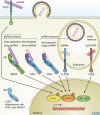Differential recognition of double-stranded RNA by RIG-I-like receptors in antiviral immunity
- PMID: 18591413
- PMCID: PMC2442628
- DOI: 10.1084/jem.20081210
Differential recognition of double-stranded RNA by RIG-I-like receptors in antiviral immunity
Abstract
Retinoic acid-inducible gene (RIG)-I-like receptors (RLRs) are cytosolic RNA helicases that sense viral RNA and trigger signaling pathways that induce the production of type I interferons (IFNs) and proinflammatory cytokines. RLRs recognize distinct and overlapping sets of viruses, but the mechanisms that dictate this specificity were unknown. A new study now provides evidence for size-based discrimination of double-stranded RNA (dsRNA) by RLRs and suggests how host cells recognize a variety of RNA viruses.
Figures

Comment on
-
Length-dependent recognition of double-stranded ribonucleic acids by retinoic acid-inducible gene-I and melanoma differentiation-associated gene 5.J Exp Med. 2008 Jul 7;205(7):1601-10. doi: 10.1084/jem.20080091. J Exp Med. 2008. PMID: 18591409 Free PMC article.
Similar articles
-
Length-dependent recognition of double-stranded ribonucleic acids by retinoic acid-inducible gene-I and melanoma differentiation-associated gene 5.J Exp Med. 2008 Jul 7;205(7):1601-10. doi: 10.1084/jem.20080091. J Exp Med. 2008. PMID: 18591409 Free PMC article.
-
Innate immunity to virus infection.Immunol Rev. 2009 Jan;227(1):75-86. doi: 10.1111/j.1600-065X.2008.00737.x. Immunol Rev. 2009. PMID: 19120477 Free PMC article. Review.
-
Retinoic acid-inducible gene-I-like receptors.J Interferon Cytokine Res. 2011 Jan;31(1):27-31. doi: 10.1089/jir.2010.0057. Epub 2010 Oct 15. J Interferon Cytokine Res. 2011. PMID: 20950133 Review.
-
Mechanisms of length-dependent recognition of viral double-stranded RNA by RIG-I.Sci Rep. 2023 Apr 18;13(1):6318. doi: 10.1038/s41598-023-33208-w. Sci Rep. 2023. PMID: 37072508 Free PMC article.
-
Expression and functional characterization of retinoic acid-inducible gene-I-like receptors of mast cells in response to viral infection.J Innate Immun. 2013;5(2):163-73. doi: 10.1159/000343895. Epub 2012 Nov 21. J Innate Immun. 2013. PMID: 23171655 Free PMC article.
Cited by
-
Multi-step regulation of innate immune signaling by Kaposi's sarcoma-associated herpesvirus.Virus Res. 2015 Nov 2;209:39-44. doi: 10.1016/j.virusres.2015.03.004. Epub 2015 Mar 19. Virus Res. 2015. PMID: 25796211 Free PMC article. Review.
-
The role of interferon antagonist, non-structural proteins in the pathogenesis and emergence of arboviruses.Viruses. 2011 Jun;3(6):629-58. doi: 10.3390/v3060629. Epub 2011 Jun 1. Viruses. 2011. PMID: 21994750 Free PMC article. Review.
-
Transcriptional profiling of hilar nodes from pigs after experimental infection with Actinobacillus pleuropneumoniae.Int J Mol Sci. 2013 Nov 29;14(12):23516-32. doi: 10.3390/ijms141223516. Int J Mol Sci. 2013. PMID: 24351863 Free PMC article.
-
Monitoring activation of the antiviral pattern recognition receptors RIG-I and PKR by limited protease digestion and native PAGE.J Vis Exp. 2014 Jul 29;(89):e51415. doi: 10.3791/51415. J Vis Exp. 2014. PMID: 25146252 Free PMC article.
-
Binding of Duck Tembusu Virus Nonstructural Protein 2A to Duck STING Disrupts Induction of Its Signal Transduction Cascade To Inhibit Beta Interferon Induction.J Virol. 2020 Apr 16;94(9):e01850-19. doi: 10.1128/JVI.01850-19. Print 2020 Apr 16. J Virol. 2020. PMID: 32075929 Free PMC article.
References
-
- Akira, S., S. Uematsu, and O. Takeuchi. 2006. Pathogen recognition and innate immunity. Cell. 124:783–801. - PubMed
-
- de Veer, M.J., M. Holko, M. Frevel, E. Walker, S. Der, J.M. Paranjape, R.H. Silverman, and B.R.G. Williams. 2001. Functional classification of interferon-stimulated genes identified using microarrays. J. Leukoc. Biol. 69:912–920. - PubMed
-
- Theofilopoulos, A.N., R. Baccala, B. Beutler, and D.H. Kono. 2005. Type I interferons (alpha/beta) in immunity and autoimmunity. Annu. Rev. Immunol. 23:307–336. - PubMed
Publication types
MeSH terms
Substances
Grants and funding
LinkOut - more resources
Full Text Sources
Other Literature Sources

